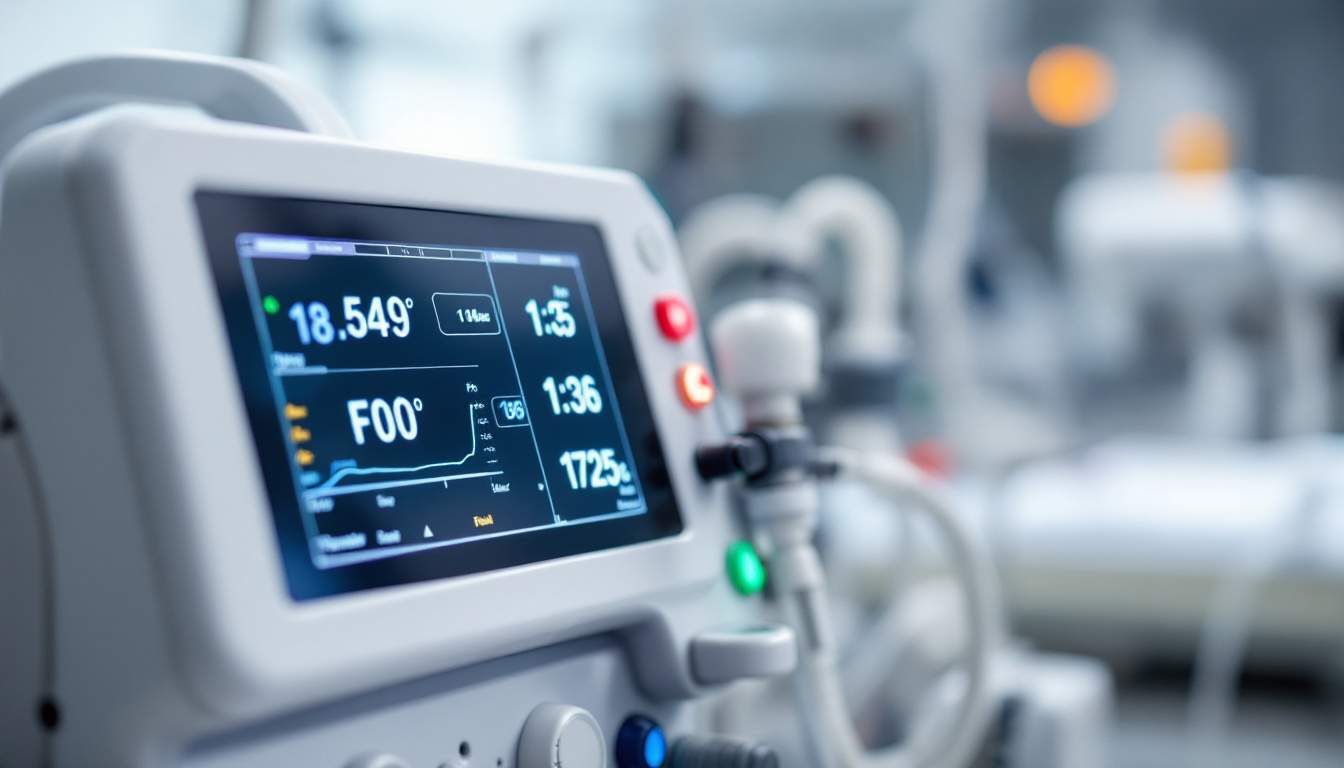Glossary: What is a Pulmonary Function Test
Understanding Pulmonary Function Testing
A pulmonary function test (PFT) is a series of non-invasive tests designed to assess how well your lungs are functioning. These tests measure airflow, lung volume, and the ability of the lungs to exchange gases efficiently. Understanding these functions is crucial for diagnosing and managing various respiratory conditions.
The primary purpose of a PFT is to determine how well your lungs are performing. This involves evaluating how much air you can breathe in and out and how well oxygen and carbon dioxide are exchanged during the breathing process. These insights can help medical professionals tailor treatment plans for individuals with respiratory issues.

Definition and Purpose of a Pulmonary Function Test
The pulmonary function test evaluates lung capacity and function to identify any abnormalities that may indicate respiratory diseases. It typically involves several components, each focusing on different aspects of lung health. The results can help doctors make informed decisions regarding patient care and treatment options.
The main purposes of these tests include diagnosing respiratory conditions, monitoring disease progression, and assessing the effectiveness of treatments. It is a critical tool in clinical settings, playing a vital role in both preventive and therapeutic strategies. For instance, spirometry, one of the most common types of PFT, measures how much air you can forcefully exhale in one second, providing valuable data on airway obstruction and lung capacity.
The Importance of a Pulmonary Function Test in Respiratory Health
Pulmonary function tests are essential in identifying underlying health issues early on, often before symptoms occur. By regularly conducting PFTs, healthcare providers can detect diseases such as chronic obstructive pulmonary disease (COPD) or asthma at an early stage, which can dramatically improve treatment outcomes.
Additionally, they help evaluate lung function over time, allowing for adjustments in treatment based on how well a patient responds. For individuals at risk, such as smokers or those with a family history of lung diseases, these tests can be incredibly valuable for preventive care. Moreover, PFTs can also be used to assess the impact of environmental factors, such as air pollution or occupational hazards, on lung health, providing a comprehensive view of a patient’s respiratory status. This multifaceted approach allows healthcare providers to not only treat existing conditions but also implement lifestyle changes that can enhance lung health and overall well-being.
Components of a Pulmonary Function Test
Several components form the basis of a comprehensive pulmonary function test, each contributing unique data that aids in the overall assessment of lung health. Key components include spirometry, lung volume measurements, and diffusion capacity testing.
Spirometry and its Role
Spirometry is one of the most common tests performed as part of the pulmonary function assessment. It measures how much air you can inhale and exhale, as well as how quickly you can do so. During this test, you will be asked to take a deep breath and then blow out as forcefully and quickly as possible into a spirometer device.
This data helps in diagnosing conditions like asthma or COPD, as it can reveal patterns suggestive of obstructive or restrictive lung diseases. By comparing your results to normal values, doctors can evaluate your lung function relative to expected norms. Furthermore, spirometry can also be used to monitor the progression of lung diseases over time, allowing for adjustments in treatment plans based on how well a patient is responding to therapy. Regular spirometry tests can provide critical insights into the effectiveness of medications and lifestyle changes aimed at improving lung health.
Lung Volume Measurements
Lung volume measurements provide additional insights into how much air your lungs can hold and how efficiently they can operate. This component may be measured using techniques such as body plethysmography or gas dilution methods, where the volume of air is recorded during breathing.
These measurements can indicate whether your lungs are functioning within a healthy range. Abnormal lung volumes may suggest restrictive lung diseases or issues like pulmonary fibrosis, which denotes reduced lung capacity affecting overall breathing ability. Additionally, understanding lung volumes can help in assessing the impact of various factors such as obesity or aging on respiratory function, as these factors can significantly alter lung capacities. This information is vital for tailoring rehabilitation programs and guiding patients in their recovery journeys, especially after surgeries or during chronic illness management.
Diffusion Capacity Testing
The diffusion capacity test assesses how well oxygen passes from your lungs into your bloodstream. It measures the efficiency of gas exchange in the alveoli—the tiny air sacs where oxygen and carbon dioxide transfer happens.
This test is particularly important in evaluating conditions like emphysema or pulmonary hypertension. By understanding how well your lungs are delivering oxygen to your body, healthcare providers can better determine the underlying causes of your symptoms or reduced exercise capacity. Moreover, diffusion capacity testing can also help in identifying the presence of interstitial lung diseases, where scarring of lung tissue can hinder gas exchange. The results from this test can be pivotal in deciding on further diagnostic procedures or treatments, making it an essential tool in the comprehensive evaluation of lung health.
The Procedure of a Pulmonary Function Test
Preparing for a pulmonary function test is important to ensure accurate results. This preparation may involve certain restrictions that can affect your performance during the test.
Preparing for a Pulmonary Function Test
Before undergoing a PFT, you may be advised to avoid smoking, vigorous exercise, or eating large meals for several hours prior to the test. It's also important to inform your healthcare provider of any medications you are taking, as some may need to be temporarily stopped to avoid skewing your results.
On arriving for the test, you’ll usually be greeted by a trained technician who will explain each step of the procedure. Understanding what to expect can alleviate anxiety and contribute to a more relaxed experience. Additionally, it may be helpful to bring along a list of your medical history, including any respiratory conditions you may have, as this information can assist the technician in tailoring the test to your specific needs.
What Happens During the Test?
During the test, you will perform various breathing maneuvers while connected to a spirometer or other specialized equipment. The technician will guide you through each step, emphasizing the importance of following directions accurately to ensure valid measurements. You may be asked to take deep breaths, exhale forcefully, or hold your breath at certain intervals, all of which help to evaluate different aspects of lung function.
The tests are generally straightforward and only take about 30 minutes to complete. After finishing the spirometry segment, you might also have different tests for lung volume and diffusion capacity, making for a comprehensive assessment. These additional tests can provide crucial insights into how well your lungs are working and how effectively they are transferring oxygen into your bloodstream, which is vital for overall health.
Post-Test Procedures and Care
Once the pulmonary function tests are finished, your healthcare provider will review the results with you. Depending on your scores, additional diagnostic tests may be recommended, or they may begin discussing potential treatment options tailored to your specific needs. It’s essential to ask questions during this time to fully understand the implications of your results and the next steps in your care plan.
Most individuals experience no side effects following a PFT, although some may feel mild fatigue or light-headedness. It's important to rest and hydrate following the procedure, especially if you felt exerted during the tests. Additionally, if you have any pre-existing conditions, such as asthma or COPD, be sure to monitor how you feel after the test and report any unusual symptoms to your healthcare provider. This follow-up can help ensure that your lung health is managed effectively and any necessary adjustments to your treatment plan can be made promptly.
Interpreting the Results of a Pulmonary Function Test
Analyzing the results generated from a pulmonary function test provides critical insights for healthcare providers and patients alike. Understanding the data can clarify the health status of your lungs and guide subsequent treatment decisions.
Understanding Test Scores and What They Mean
The results from a PFT are typically presented as a series of numbers and graphs that indicate how well your lungs are working. These may include values for forced vital capacity (FVC), forced expiratory volume (FEV1), and the FEV1/FVC ratio. Each of these metrics serves as an indicator of lung function.
For example, a lower than average FEV1 value may suggest airway obstruction, while a reduced FVC score can indicate restrictive lung disease. Comparing these scores to normative data helps physicians categorize the severity of any lung conditions. Additionally, the peak expiratory flow rate (PEFR) is another important measure that can provide insight into the maximum speed of expiration, which is particularly useful in assessing conditions like asthma where airflow limitation is a concern.
Potential Abnormalities and Their Implications
Abnormal results can signal a range of respiratory issues. In some cases, results may indicate a condition that is reversible, such as asthma, and can often be managed effectively with medications and lifestyle changes. In contrast, other conditions, such as chronic pulmonary diseases, may require ongoing management. Furthermore, specific patterns in the test results can help differentiate between obstructive and restrictive lung diseases, guiding the healthcare provider in tailoring a treatment plan that is most appropriate for the patient's unique situation.
Understanding the implications of these results ensures informed discussions between patients and their healthcare teams about the best course of action and further diagnostic investigation as needed. Moreover, it opens the door for patients to engage in proactive health management strategies, such as pulmonary rehabilitation programs, which can significantly improve lung function and overall quality of life. Education about the condition, potential triggers, and self-management techniques is essential, empowering patients to take an active role in their healthcare journey and fostering a collaborative relationship with their providers.
Risks and Considerations of Pulmonary Function Test
While pulmonary function tests are generally safe, they aren't without risks or considerations that should be taken into account. Careful evaluation of each patient’s health status and conditions is crucial for proper test administration. It is important to note that the accuracy of the test results can be influenced by various factors, including the patient's effort during the test, the presence of respiratory infections, and even environmental conditions such as air quality on the day of testing.
Who Should Avoid Pulmonary Function Tests?
Certain individuals may be advised against a PFT, particularly if they have recently suffered from a heart attack, have uncontrolled asthma, or severe respiratory distress. Moreover, those who have undergone recent surgeries that could affect breathing may also need to postpone the test. Additionally, patients with certain neurological disorders that impair their ability to follow instructions or cooperate during the test may also be at risk for inaccurate results, making it essential to assess their individual circumstances prior to testing.
Discussing all relevant medical histories with your healthcare provider is essential to ensure that a PFT is appropriate for your health condition. It is also beneficial for patients to inform their doctors about any medications they are taking, as some drugs may affect lung function or the results of the test. For instance, bronchodilators, which are commonly used to treat asthma, can alter the outcomes of the test if taken shortly before the procedure.
Possible Complications and How to Mitigate Them
While complications are rare, some individuals may experience shortness of breath, dizziness, or anxiety during the test. Ensuring patients are well-prepared and understand the procedure can help alleviate many potential side effects. Providing a calm and reassuring environment, along with clear instructions, can significantly enhance the patient's comfort level. In some cases, healthcare providers may recommend relaxation techniques or breathing exercises prior to the test to help manage anxiety.
If you have concerns about your health before the test, your provider can work with you to develop a plan that mitigates risks while still allowing for an accurate assessment of your lung function. This may include scheduling the test at a time when you are feeling your best or considering alternative testing methods that may be less taxing on your respiratory system. Additionally, monitoring vital signs throughout the procedure can help ensure that any adverse reactions are promptly addressed, providing peace of mind for both the patient and the healthcare team.
The Role of Pulmonary Function Test in Disease Diagnosis
Pulmonary function tests play an integral role in diagnosing various respiratory conditions. By offering a comprehensive evaluation of lung function, these tests help identify diseases early, potentially leading to more effective outcomes. They measure how well the lungs are working by assessing airflow, lung volume, and gas exchange, providing clinicians with essential data to inform their diagnostic processes.

Detecting Chronic Obstructive Pulmonary Disease (COPD)
COPD is one of the primary conditions diagnosed using pulmonary function tests. The obstructive patterns identified through spirometry are often indicative of COPD, allowing healthcare professionals to evaluate the severity and provide appropriate treatment plans. The tests measure the forced expiratory volume (FEV1) and the forced vital capacity (FVC), which are crucial in determining the presence and extent of airway obstruction.
Early detection of COPD can be crucial, as interventions like smoking cessation or inhaled medications can vastly improve the quality of life for affected individuals. Moreover, routine monitoring through pulmonary function tests can help track disease progression and response to treatment, enabling healthcare providers to make timely adjustments to therapy. This proactive approach not only enhances patient outcomes but also reduces the risk of exacerbations that can lead to hospitalizations.
Identifying Asthma and Other Respiratory Conditions
Asthma can also be diagnosed and managed using results from pulmonary function tests. The results help classify the severity of asthma and determine potential triggers or patterns relating to the status of lung function. For instance, peak flow measurements can be used to monitor asthma control, allowing patients and physicians to identify worsening symptoms before they escalate into a full-blown attack.
Identifying other respiratory conditions, such as interstitial lung disease or pulmonary fibrosis, can also be achieved through close analysis of PFT results. This comprehensive assessment is vital in tailoring individualized treatment plans for different respiratory issues. Additionally, pulmonary function tests can provide insights into restrictive lung diseases, where lung volumes are reduced, helping to differentiate between various underlying causes. By understanding the specific nature of a patient's condition, healthcare providers can implement targeted therapies that address the root causes of respiratory distress, ultimately improving patient care and outcomes.
Frequently Asked Questions About Pulmonary Function Test
Understanding the intricacies of pulmonary function tests leads to several common queries. Clarifying these concerns is essential for patients preparing to undergo the test.
Common Concerns and Misconceptions
One prevalent concern is the fear of discomfort during the test. While some individuals may experience mild discomfort, most find the test is less invasive and intimidating than perceived. Education on what to expect can ease these fears significantly.
Another common misconception is that pulmonary function tests are only necessary for those experiencing severe symptoms. In reality, these tests can benefit anyone with risk factors for lung disease, helping to manage and prevent conditions early.
Expert Answers to Your Queries
If you have further questions regarding pulmonary function tests, don't hesitate to talk with your healthcare provider. They can provide personalized advice that pertains to your specific health needs and explain any components of the tests you may be uncertain about.
Ultimately, understanding the pulmonary function test can empower patients, making them active participants in their healthcare journey. Knowledge fosters better communication with medical teams, ensuring informed and effective management of respiratory health.
If you're interested in taking proactive steps towards understanding and improving your respiratory health, Alveo's innovative Continuous Respiratory Wearable is the perfect companion for your journey. With Alveo, you can monitor your breathing patterns in real-time, receive personalized breathing routines, and gain valuable insights into how your environment affects your lung function—all with the comfort and ease of everyday wear. Don't miss out on the opportunity to enhance your lung health. Sign up on our waiting list today and be one of the first to experience the future of respiratory care with Alveo.




